QuestionWe adopted a 14 mo. cockapoo (BELLA) 4 weeks ago. We already had 2 senior cats and a 13 mo. old cockapoo (LILLY). From her 1st day with us, Bella began mounting Lilly. For about 2 weeks, it was constant. We tried to correct her but Lilly didn't seem to mind at all and our vet said to let it go as Bella was just showing dominance. Although the mounting has greatly decreased (only about once a day), Bella has developed a terrible habit of "messing" in the house. IN the 4 weeks we have had her, it seems to have gotten worse and worse (today it happened twice!). She and Lilly get along great-- they have never had a cross or crabby moment together! She seems super happy! What are we doing wrong?! What can we do to stop the behavior??? I should also add that we crate trained Lilly and she does very well... she alerts us when she wants to go out and hasn't had any accidents. Bella does not bark to go out at all.
AnswerHi Nora,
Thank you for contacting me regarding Bella, the new addition to your furry family. I am happy to hear that the relationship between Bella and Lilly has worked out and that both girls are happy.
It is essential to find out if Bella's urination problems are medical or emotional. I would therefore suggest a thorough examination by your vet, including bloodwork and a urine analysis.
14 months is still young for a dog that has made a major change in her short life. She may have been given up for adoption because the previous owners were unable to house break her. The challenge is now in your hands and because of the positive relationship between Bella and Lilly, it would be worth the time and energy to get this issue under control.
If there are no medical issues than Bella's housebreaking problem will have to be addressed as you would for a young puppy. It is housebreaking 101 for Bella from now on!
Housebreaking in theory is very simple. It is a means of preventing your dog from doing her business in the house and only giving her the opportunity to do it outside. It also means that your dog learns to communicate with you about going when told to go and about letting you know when she has to go outside.
A dog is a creature of habit and because she learns by association, if her training is consistent she will quickly learn there is no other place to relieve himself other than outdoors. If you can crate train her, it would be very helpful in addressing this problem. Keep a bowl of all-natural dog treats near the crate. Every time you put
your Bella in the crate give a "CRATE" command and toss 3 or 4 liver treats into the crate. It gives your girl a nice reason to go in. You will be surprised how quickly she expects to get a treat when she goes into hercrate. Going in becomes a positive experience.
Start crate training while you remain in the same room with your crated dog, frequently praising her and letting her know clearly it is pleasing to you that she remains in the crate, quietly. Frequent trips out of the room with quick returns with a treat through the bars will condition your
dog to your comings and goings.
Gradually extend your absent periods, and in a short time, you can be gone several hours. While in the crate, your dog should never be scolded.
Crate confinement works so well that most dogs soon choose the crate for naps and, in general, consider it their own private domain. They learn that they can go into their crate and sleep and no one will step on them or jump on them. You can also feed your dog in her crate to make it an even most positive place for her to spend time in.
At night take Bella out and give her an opportunity to do her duties. If you are in a protected area (a fenced back yard) let her go free of the leash. Be sure to stay out there with her. Lavishly praise her with GOOD GIRL when she has completed her duties. Take her inside at once and put
her in her bed.
A dog in housebreaking training is NEVER ALLOWED TO HAVE FREE ACCESS TO THE HOUSE unless you have your eyes on her at all times. If she peess on the floor because you turned your back for 45 seconds - you made a mistake, not your dog.
The only time Bella can be loose inside is just after she has come in from going outside and then only for short periods of time.
Bella must go out first thing in the morning (and I mean first thing) take her outside. She's been clean all night - and holding it all night -she will do her business in a hurry because SHE HAS TO GO. Now bring her in and give her freedom, but in the kitchen only. A child's gate at the
kitchen doorway is an excellent barrier to the other rooms in the house.
Give her freedom while breakfast is being prepared and while you are eating breakfast. After your breakfast, and when you have time to take her out, feed her breakfast - and take her out immediately. Remember the rule - outside after each meal. Do not leave food or water down her she
will do her business immediately afterward, when you aren't there to take her out. Dogs relieve themselves after SLEEPING- EATING AND HAVING EXERCISE.
Now bring her in and put her in the crate and go about your normal routine of the morning. She should stay in the crate until about 11:00 to 11:30 A.M. Then out of the crate and outside. Bring her in, and while you are preparing and eating lunch let her have the freedom of the kitchen but
only when you have "eyes on your dog".
At dinner time as soon as she has finished her last mouthful - take her outside. After she has completed her business, bring her in and again give her the freedom of the kitchen while you are preparing dinner and during
the dinner hour. Give her another trip outside about 8:00 P.M. - and again just before your bedtime. Some dogs need to be exercised more than others to get them to relieve themselves. Exercises always increases the urge to
pee or poop. Keep your dog outside for up to 30 minutes to insure that she will go. Prevention is the key to success.
The bottom line is you cannot take your dog outside too much. If you take her out every couples of hours then she learns that she is going to have a chance to go outside to do her business.
We want to establish a pattern and what better way than to take your dog out all the time. Also do not underestimate how important it is to ask your dog if she WANTS TO GO OUTSIDE just before going out and praising GOOD GIRL when SHE DOES GO.
One last point on your dogs house breaking. A commercial kibble diet takes 14 to 15 hours to go through a dog. An all-natural diet goes through the dog in 5 to 6 hours. I strongly recommend that you consider doing research on all-natural diets.
A couple of points on how to housetrain your dog:
1. Do not vary your dog's diet.
2. Snacks or treats are forbidden.
3- Bring her in as soon as she does her business.
4- Praise every time you see her pee or poop. Do this forever. Reinforcing good behavior never hurt anything.
5- Dogs who go out and just dink around and then go in their crate need more exercises when they go outside. A long walk will often cure the problem. BE SURE TO PRAISE - then when you have your dog in the house
and say "DO YOU WANT TO GO OUTSIDE" she will learn what you mean.
6- Older dogs are house trained exactly like young pups.
Using An Odor Neutralizer And Indoor Spray Repellent (peroxide and vinegar are excellent).
When a handler makes a mistake and allows a dog to pee in the house, you have to get rid of the odor. This is accomplished with an odor neutralizer, which is available in pet stores or you can try using straight vinegar or peroxide. (Do not use household cleaners as they contain ammonia and will attract her back to the same spot.) When used properly it will completely eliminate these odors, discerned only by the dog, by neutralizing the scent. When areas previously used by the dog have been neutralized the incentive for using the same spot will be eliminated.
Proper Correction
Under no circumstances should your dog be punished for relieving herself in the house, unless you catch her in the act. The punishment should be a verbal scolding not physical harm.
A dog has no mental capacity to connect your wrath with whatever she did wrong, even a few minutes earlier. If you cannot get to your dog while she is doing her business then you have screwed up. Dogs simply cannot put two and two together to understand why you would be mad about her peeing
on the rug. It is confusing to her and you only get a puzzled whimper. Catch her in the act or scolding is no good. I don't recommend scolding at all but only prevention as it is not her fault at all.
The old adage of rubbing a dogs nose in it is stupid. We don;t do this to our kids and we should not do this to our dogs. Anyone who recommends this needs a good swift kick.
Many people are mistakenly convinced that a dog messes in the house for spite or revenge, usually for having been left alone. This is incorrect. It is for reasons of anxiety, nervousness or fear that they might behave this
way...or simply that she is not properly housebroken. Very often an owner comes home and finds the dog behaving in a fearful, shameful, or generally guilt-ridden manner. It is because of this that the owner is convinced the dog has messed in the house for spite. It's simply not true. The dog
cringes when you come home because she associates your arrival with punishment. YOu have conditioned her (and it only takes ONE TIME) to be afraid when you came home in the past.
Are you picking the water up at 6:30 pm?
Are you giving your dog enough exercise to make her tired before she goes to bed?
Your dog needs to learn that she must go in the crate and calm down.
If you are convinced your dog just wants to come out and play after a few hours , then ignore her. If there is a mess in the crate later on - then YOU MADE A MISTAKE - not your dog.
With a little effort on your part and the use of this method, Bella can be housebroken very quickly.
If you don't think that Bella can be crate trained, you can try using a baby gate in a very safe area of the house, or an X-pen (J&B Wholdsale Pet Supplies). While you are home you can tether Bella to you which will prevent her from peeing and will strengthen the bond between you. It also put you in control.
Retraining a dog that has already established bad habits can take six weeks or more.
As soon as possible get Bella to the vet for a complete check-up. This will assure you that she is healthy and will altet you to any medical complications that can make house training more difficult.
Situations such as intestinal upset, intestinal parasites and urinary tract infections can make house training difficult to impossible.
The designated toilet area can be as general as outside of the house or as specific as a particular corner of the backyard. You must have a specific plan as to what the designated area is going to be. You can not teach your
dog what is acceptable if you are uncertain.
Your attitude is one of the most important ingredients in house training your dog. Your pooch does not know what is wrong. If there is a mistake tell her "no" but do not discipline too severely. You only want her to know that you are displeased, you do not want her to feel that you
are the source of pain.
When your dog has done well, pat her, praise her, let your dog know that you are very pleased. Your dog will want to do things that please you.
Scheduling:
1. Create a schedule that is practical for you to maintain. If you can not stick to your schedule - you can't expect your dog to adhere to it.
2. Do not allow your dog to free feed until house training is well established. Be very careful of your dogs diet - avoid foods and/or snacks that can be upsetting to her digestive tract.
3. Schedule your dog's bed time and waking-up time. Adhere to these times as closely as possible.
4. Emotional intensity - after intense emotional stimulation (badly scared, frightened, or a particularly rowdy play session) your dog may need to relieve herself.
Supervise in the House :
1. By knowing where your dog is at all timdog stops playing and starts to sniff around for a "good spot", she needs to go out. By observing your dog you will quickly learn to tell the difference between your dog's exploring her
universe and her searching for a "good location".
2. If your dog starts to make a mistake, firmly but quietly say "No" and take her straight to her toilet area. Do not yell at your dog. Do not chase your dog. At this point it is up to you to be observant of your dog. Any mistakes that are made are due to your not paying attention.
3. If you can not supervise your dog for a period of time, put her in a confinement area or confine her to the room where you are.
4. When you are relaxing (watching TV, reading or on computer), have your dog with you. Give her some of her toys to play with. Have your dog on her leash or confine her to the room where you are, so that she doesn't
wander out and have an accident. Teach her that it can be enjoyable just being with you. When you can't be with your dog:
1. Provide a small area confinement area (bathroom with all "chewable" items removed, fenced off area of the garage, or a crate).
2. Do not leave food and water with your dog, or fill her with cookies or snacks before you leave. You should schedule your dog's breakfast to be at least 2 hours before your planned departure time. That way she can eat, digest her food and relieve herself prior to your departure.
3. Ideally, if you are going to be gone for more than eight hours, someone should give your dog a drink and an opportunity to relieve herself several times during the day.
Taking your dog out:
1. Take your dog on leash to the designated toilet area. Stand quietly, so that she can find the right spot. Do not distract her. Do not praise her during her search. If after about a time your dog hasn't gone to the bathroom, return her to the house (keeping a close eye on her) for
about 1/2 hour, then try again.
2. When she does go, calmly praise her. Use a chosen word or phrase (good potty or wonderful potty). This phrase will only be used for praise in going potty.
3. When your dog has finished relieving herself praise her very enthusiastically. Let her know that you are very proud of her.
4. Remember your dog's routine. Some dogs will "potty" two or three times per outing in the morning, but only twice per outing in the evening. Urination is often followed by defecation, while other dogs will do the reverse.
5. Even if the weather is foul, do not let your dog know that you don't want to be going outside with her. By teaching your dog that even in bad weather going outside is "the thing to do", to please you, then she will be
more willing to convey her needs to you.
6. While you are learning your dog's "time table", take her out immediately after she wakes up, after she has eaten and after all play sessions.
Catching your dog "in the act" :
1. Without yelling, firmly say "No". If you still don't have your dog's attention, clap your hands.
2. Get your dog outside, to the designated latrine area. If your dog relieves herself outside praise her. Proceed with the potty routine.
3. Clean the mess with a deodorizing or odor killing cleanser, peroxide or vinegar. If your dog smells her own scent as having been used as a bathroom area, she will continue to use the area.
If the cleanser is not able to eliminate enough of the scent so that your dog can not detect it, you can help mask the scent over with vanilla extract. Just one or two drops will make it impossible for your dog to smell any lingering odor.
I wish you all the luck with training your precious puppy. Everything you do now, sets the tone for the rest of your dog's life.
Best,
Shelley Davis
www.bednbiscuit.com

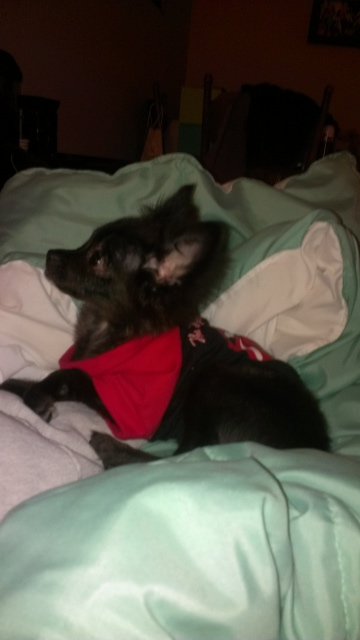 dog size
Question
raven
I have a 5 month old Pomeranian/C
dog size
Question
raven
I have a 5 month old Pomeranian/C
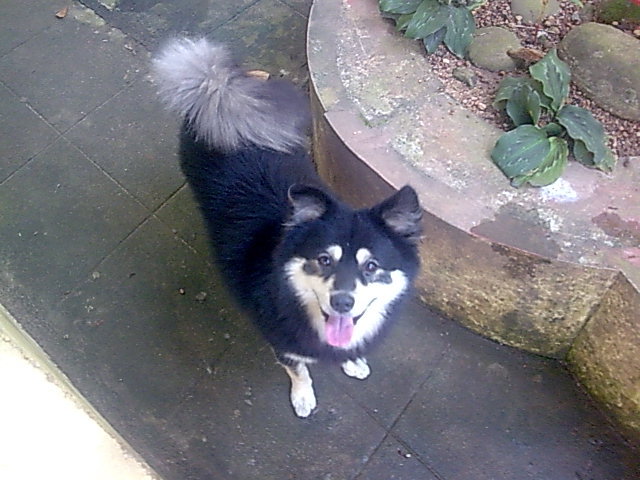 pooping and peeing
Question
snoopy
hi, my name is praveen n i have a dog t
pooping and peeing
Question
snoopy
hi, my name is praveen n i have a dog t
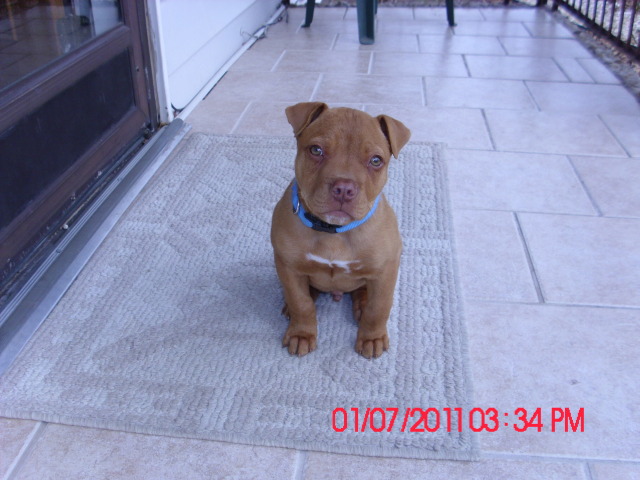 puppy medical concerns
Question
Rusty
my 11 week old red nose pit bull at time
puppy medical concerns
Question
Rusty
my 11 week old red nose pit bull at time
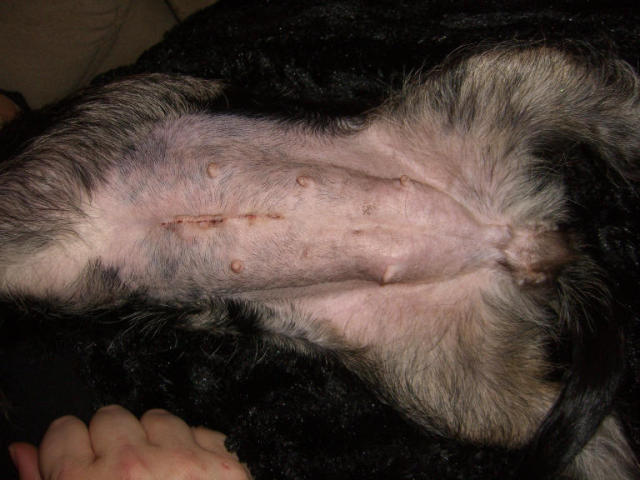 Dachshund spay - swollen mammaries
Question
Lilly
Hi Patti,
We took our 10 month old mini
Dachshund spay - swollen mammaries
Question
Lilly
Hi Patti,
We took our 10 month old mini
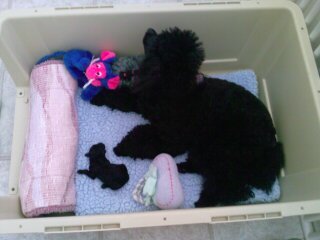 Diarrhea in Nursing Bitches
QuestionAtrix & Pup
QUESTION: My Champion Mi
Diarrhea in Nursing Bitches
QuestionAtrix & Pup
QUESTION: My Champion Mi